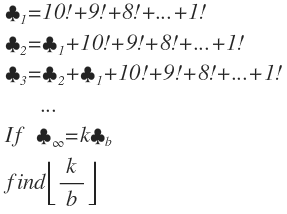This section requires Javascript.
You are seeing this because something didn't load right. We suggest you, (a) try
refreshing the page, (b) enabling javascript if it is disabled on your browser and,
finally, (c)
loading the
non-javascript version of this page
. We're sorry about the hassle.

I have some questions about this question.
To start solving this question, I began by defining ♣ 1 = x , for purely simplification reasons. I then observed that:
♣ 1 = x
♣ 2 = ♣ 1 + ♣ 1 = 2 ♣ 1
♣ 3 = ♣ 2 + ♣ 1 + x = ♣ 2 + ♣ 2 = 2 ♣ 2
⋮
(1) ♣ n = 2 ♣ n − 1 , where n is a natural number s.t. n ∈ ( 1 , ∞ )
I then came to a metaphorical fork in the road. I was not certain whether the problem wanted (1) to be simplified in the form:
(2) ♣ n = 2 n + 1 ♣ 1 , or not
Equation (2) can be obtained by observing the pattern of the equations obtained by substituting each occurrence of ♣ n − 1 with twice the previous term, ad infintum .
Although both (1) and (2) are equal, they would have very different conclusions as to the solution of the question. (1) would imply that:
⌊ b k ⌋ = lim b → ∞ ⌊ b 2 ⌋ = 0 , which is the answer that was set as correct.
However (2) would imply that:
⌊ b k ⌋ = lim n → ∞ ⌊ n − 1 2 n + 1 ⌋ , which can be shown through the ratio test to be equal to lim k → ∞ ⌊ k ⌋ = ∞ . Therefore the answer to the question is ∞ . This answer is somewhat different.
I guess my main difficulty resides in the lack of specification of b. Is the question asking for b, s.t. b is a finite number or not?